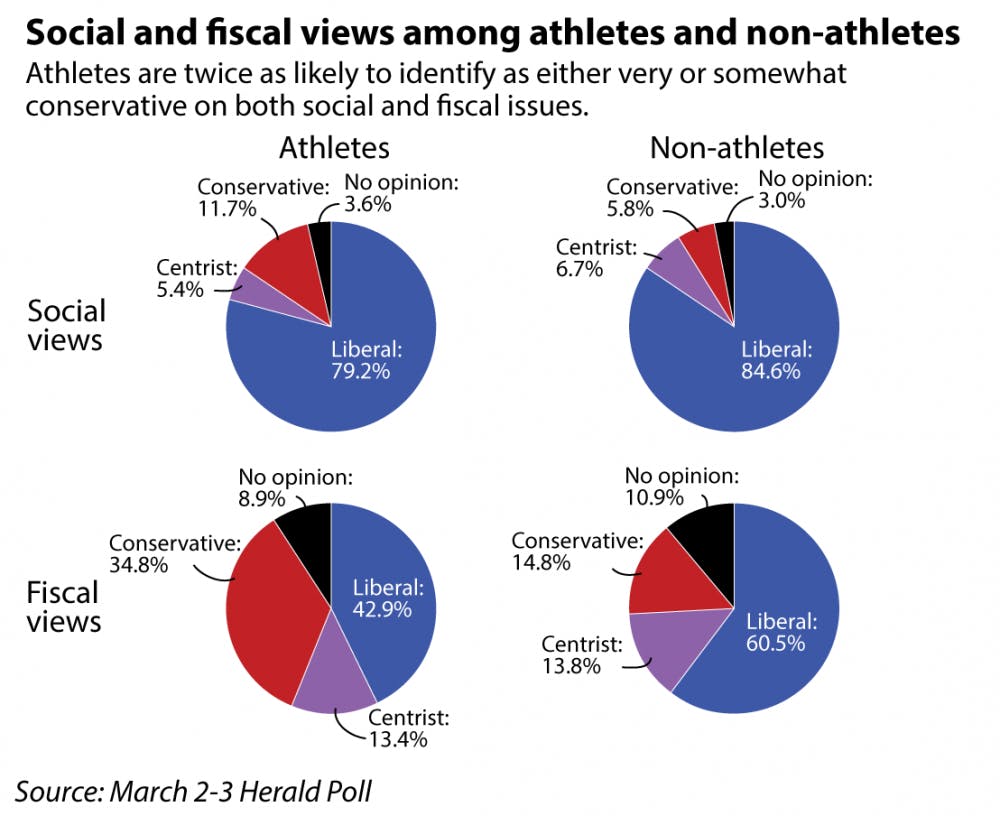A Herald poll of undergraduates conducted March 2-3 found that conservative beliefs are twice as prevalent among athletes as among non-athletes at Brown. About a dozen athletes interviewed said this trend is readily apparent on their teams and could be attributed to socioeconomic and geographic backgrounds, the competitive nature of collegiate sports and the priorities of recruited athletes.
Only 6 percent of non-athletes identified as socially conservative compared to 12 percent of athletes. Meanwhile, 15 percent of non-athletes identified as fiscally conservative compared to 35 percent of athletes.
“It’s a lot more fiscally conservative than socially conservative,” said Pearson Potts ’16, a member of the sailing team, adding that athletes are more “libertarian.”
“Most athletes seem to me to be apolitical, but when push comes to shove, gravitate toward fiscal conservatism,” wrote Hunter Davis ’16, a member of the women’s ice hockey team and the Brown Democrats, in an email to The Herald.
Many student athletes expressed little surprise at the poll’s findings.
Some traced the trend back to sports that often draw players from higher socioeconomic backgrounds.
“Think of sports like golf or squash or lacrosse,” said Thomas Blecher ’18, a member of the men’s squash team. “Those sports are more targeted towards the well-off.”
“The high-cost sports are probably more conservative,” Potts said. “Republicans have this stigma of being the wealthy elitist, and that sort of embodies a lot of those sports.”
Sports such as crew, sailing, equestrian, squash, hockey and lacrosse are “high-cost” sports due to pricy equipment, he said.
“A lot of my friends rowed at prep schools — the background of an athlete is conducive to being conservative,” said Hunter Leeming ’15, a member of the men’s crew team.
“It’s expensive to run a crew program, and (it’s) the same thing with squash,” said Jimmy Bell ’18, a member of the wrestling team. “Those things tend to be accessible to people with money, and those areas tend to be more conservative,” he said, describing what he called “country club” areas in lower New England.
“All of my friends who play lacrosse and squash and row crew are so red,” Bell said. “Lacrosse, crew and squash are bred in areas where conservativism is a badge of pride.”
But even in sports not dominated by the affluent, like wrestling, a conservative philosophy predominates, Bell said.
“Wrestling is a team sport, but at the end of the day, it’s just you,” he said, adding that this mentality corresponds with the staunch individualism that conservatives stand for.
Other more financially accessible sports include soccer, basketball and football — all of which are staples at high schools across the country.
“I wouldn’t say at Brown that football is considered an upper-class sport,” said Xavier Russo ’15, a member of the football team. “You definitely get the kids that are the quarterback type that come from a nice family, but then you also get the players that don’t come from much at all,” he said.
Despite the team’s socioeconomic diversity, a conservative ethos still exists, Russo said. “It’s no secret that we’re on a conservative team. It’s just a fact.”
Geographic trends may contribute to these conservative tendencies, as many football players hail from Southern or Midwestern states — areas of the country that are typically more right-leaning.
In addition to geographic factors, conservatism among athletes may also be explained by sports’ competitive nature.
“Conservatives have this mentality of pulling yourself up from your bootstraps,” Potts said. “Athletes are taught that culture.”
Athletes may also have different priorities when choosing a college, placing greater emphasis on athletic programs and coaches than campus political climate.
“Brown typically attracts non-athlete students to a very liberal institution, and when kids are recruited to play a sport, they’re drawn more to an athletic program than the atmosphere,” Russo said.
“Athletes don’t choose (Brown) for the liberal environment,” said Katherine Kallergis ’18, a member of the field hockey team.
Athletes who held conservative beliefs growing up may find it easier to maintain their conservative ideals after coming to Brown than non-athletes.
“Being in a group of more conservative people … it’s easier to hold on to more conservative ideas,” said Barrett Weiss ’15, a member of the fencing team. “Coming into the general student body is a much more liberalizing environment.”
The Herald poll found that 52 percent of students with very conservative fiscal views and 45 percent with somewhat conservative fiscal views are uncomfortable expressing those views on campus. Only 12 percent of very liberal students and 18 percent of somewhat liberal students indicated discomfort.
Many athletes said they feel more comfortable voicing conservative opinions among their teammates than in the classroom.
“In the population that I’m with the most, it’s not unheard of to be conservative,” said Briana Irons ’18, a member of the women’s lacrosse team. “In the non-athlete world, there are so many more social activists. In the locker room, we’re not really concerned about that,” she said.
Russo said he and fellow football players “talk about how we feel like we’re the minority at Brown because we have more conservative views, and we feel like people look down on it.” This sentiment is not specific to conservative athletes but true for conservative students in general, he added.
“There’s a certain stigma at Brown,” said Allie Schaefer ’17, vice president of Brown Republicans. “People with more conservative values or beliefs don’t always feel comfortable speaking up in class,” she said.
“In class, it’s kind of one-sided,” said Mark Buda ’17, a member of the men’s track and field team. “There are only liberal students.”
“A lot of my teammates are more similar to what I grew up with,” Buda said. “It’s more what I’m used to from high school,” he said, adding that his high school was “more well-balanced” politically.





